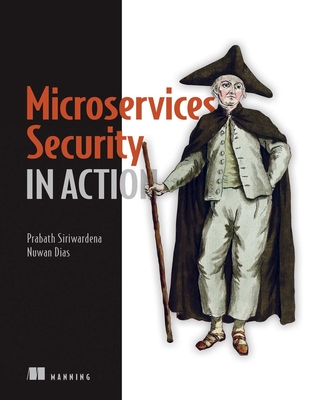Building a HIPAA-Compliant Cybersecurity Program: Using NIST 800-30 and CSF to Secure Protected Health Information
暫譯: 建立符合HIPAA的網路安全計畫:使用NIST 800-30和CSF來保護健康資訊
Eric C. Thompson
買這商品的人也買了...
-
 Linux 驅動程式, 3/e (Linux Device Drivers, 3/e)
Linux 驅動程式, 3/e (Linux Device Drivers, 3/e)$980$774 -
 $352低功耗藍牙開發權威指南
$352低功耗藍牙開發權威指南 -
 使用者故事對照 (User Story Mapping: Discover the Whole Story, Build the Right Product)
使用者故事對照 (User Story Mapping: Discover the Whole Story, Build the Right Product)$580$458 -
 打動人心的產品設計|頂尖設計師打造成功產品的黃金法則 (Designing Products People Love: How Great Designers Create Successful Products)
打動人心的產品設計|頂尖設計師打造成功產品的黃金法則 (Designing Products People Love: How Great Designers Create Successful Products)$580$458 -
 3天搞懂財經資訊:看懂財經新聞、企業財報不求人,找出年年下蛋的金雞母!
3天搞懂財經資訊:看懂財經新聞、企業財報不求人,找出年年下蛋的金雞母!$300$255 -
 3天搞懂基金買賣:3000元起,累積你的第一桶金 (最新增訂版)
3天搞懂基金買賣:3000元起,累積你的第一桶金 (最新增訂版)$300$237 -
 $500汽車黑客大曝光 (The Car Hacker's Handbook:A Guide for the Penetration Tester)
$500汽車黑客大曝光 (The Car Hacker's Handbook:A Guide for the Penetration Tester) -
 3天搞懂資產配置:存富、創富、守富、傳富,四步驟靈活規劃財富藍圖,投資理財一把罩!
3天搞懂資產配置:存富、創富、守富、傳富,四步驟靈活規劃財富藍圖,投資理財一把罩!$300$255 -
 $454黑客大曝光:工業控制系統安全 (Hacking Exposed Industrial Control Systems: ICS and SCADA Security Secrets & Solutions)
$454黑客大曝光:工業控制系統安全 (Hacking Exposed Industrial Control Systems: ICS and SCADA Security Secrets & Solutions) -
 人人可作卡米狗:從零打造自己的 LINE 聊天機器人
人人可作卡米狗:從零打造自己的 LINE 聊天機器人$500$390 -
 3天搞懂 ETF 投資:跨市跨境高CP值,讓你繞著地球轉N圈!
3天搞懂 ETF 投資:跨市跨境高CP值,讓你繞著地球轉N圈!$300$255 -
 MIS 一定要懂的 82個伺服器建置與管理知識
MIS 一定要懂的 82個伺服器建置與管理知識$420$331 -
 領域驅動設計:軟體核心複雜度的解決方法 (Domain-Driven Design: Tackling Complexity in the Heart of Software)
領域驅動設計:軟體核心複雜度的解決方法 (Domain-Driven Design: Tackling Complexity in the Heart of Software)$680$578 -
 圖解資訊安全與個資保護|網路時代人人要懂的自保術
圖解資訊安全與個資保護|網路時代人人要懂的自保術$380$300 -
 區塊鏈的商業應用成功實例|企業轉型x創新x營收成長 (Blockchain for Business)
區塊鏈的商業應用成功實例|企業轉型x創新x營收成長 (Blockchain for Business)$380$266 -
 史上最完整細節:Kubernetes 超應用全書
史上最完整細節:Kubernetes 超應用全書$980$774 -
 Microservices Security in Action
Microservices Security in Action$1,980$1,881 -
 Go語言高併發與微服務實戰
Go語言高併發與微服務實戰$534$507 -
 深入淺出 Go (Head First Go)
深入淺出 Go (Head First Go)$880$695 -
 $1,010CISSP 權威指南, 8/e (CISSP All-in-One Exam Guide, 8/e)
$1,010CISSP 權威指南, 8/e (CISSP All-in-One Exam Guide, 8/e) -
 無卡無現金時代:網路支付業務規劃設計及實作
無卡無現金時代:網路支付業務規劃設計及實作$690$545 -
 $505DevSecOps 實戰
$505DevSecOps 實戰 -
 The Hacker Playbook 3 中文版:滲透測試實戰 (紅隊版)
The Hacker Playbook 3 中文版:滲透測試實戰 (紅隊版)$650$507 -
 CYBERSEC 2022 臺灣資安年鑑 ─ 零信任資安時代來臨:信任邊界徹底瓦解,安全需源自反覆驗證
CYBERSEC 2022 臺灣資安年鑑 ─ 零信任資安時代來臨:信任邊界徹底瓦解,安全需源自反覆驗證$179$141
相關主題
商品描述
Use this book to learn how to conduct a timely and thorough Risk Analysis and Assessment documenting all risks to the confidentiality, integrity, and availability of electronic Protected Health Information (ePHI), which is a key component of the HIPAA Security Rule. The requirement is a focus area for the Department of Health and Human Services (HHS) Office for Civil Rights (OCR) during breach investigations and compliance audits. This book lays out a plan for healthcare organizations of all types to successfully comply with these requirements and use the output to build upon the cybersecurity program.
With the proliferation of cybersecurity breaches, the number of healthcare providers, payers, and business associates investigated by the OCR has risen significantly. It is not unusual for additional penalties to be levied when victims of breaches cannot demonstrate that an enterprise-wide risk assessment exists, comprehensive enough to document all of the risks to ePHI.
Why is it that so many covered entities and business associates fail to comply with this fundamental safeguard? Building a HIPAA Compliant Cybersecurity Program cuts through the confusion and ambiguity of regulatory requirements and provides detailed guidance to help readers:
- Understand and document all known instances where patient data exist
- Know what regulators want and expect from the risk analysis process
- Assess and analyze the level of severity that each risk poses to ePHI
- Focus on the beneficial outcomes of the process: understanding real risks, and optimizing deployment of resources and alignment with business objectives
What You’ll Learn
- Use NIST 800-30 to execute a risk analysis and assessment, which meets the expectations of regulators such as the Office for Civil Rights (OCR)
- Understand why this is not just a compliance exercise, but a way to take back control of protecting ePHI
- Leverage the risk analysis process to improve your cybersecurity program
- Know the value of integrating technical assessments to further define risk management activities
- Employ an iterative process that continuously assesses the environment to identify improvement opportunities
Who This Book Is For
Cybersecurity, privacy, and compliance professionals working for organizations responsible for creating, maintaining, storing, and protecting patient information
商品描述(中文翻譯)
使用本書學習如何進行及時且徹底的風險分析與評估,記錄所有對電子受保護健康資訊(ePHI)之機密性、完整性和可用性造成風險的因素,這是 HIPAA 安全規則的關鍵組成部分。該要求是美國衛生與公共服務部(HHS)民權辦公室(OCR)在違規調查和合規審核中的重點領域。本書為各類醫療機構提供了一個計劃,以成功遵守這些要求並利用結果來增強其網絡安全計劃。
隨著網絡安全違規事件的激增,受到 OCR 調查的醫療提供者、支付者和商業夥伴的數量顯著增加。當違規事件的受害者無法證明存在一個全面的企業風險評估時,通常會面臨額外的處罰,該評估必須足夠全面以記錄所有對 ePHI 的風險。
為什麼這麼多受保護實體和商業夥伴未能遵守這一基本保障?《建立符合 HIPAA 的網絡安全計劃》澄清了監管要求的混淆和模糊之處,並提供詳細指導,幫助讀者:
- 理解並記錄所有已知的患者數據存在的情況
- 知道監管機構希望從風險分析過程中獲得什麼
- 評估和分析每個風險對 ePHI 造成的嚴重程度
- 專注於過程的有益結果:理解實際風險,優化資源部署並與業務目標對齊
您將學到的內容:
- 使用 NIST 800-30 執行風險分析和評估,以滿足如民權辦公室(OCR)等監管機構的期望
- 理解為什麼這不僅僅是一個合規性練習,而是重新掌控保護 ePHI 的方式
- 利用風險分析過程來改善您的網絡安全計劃
- 知道整合技術評估以進一步定義風險管理活動的價值
- 採用一個持續評估環境以識別改進機會的迭代過程
本書適合於:
從事網絡安全、隱私和合規工作的專業人士,這些人所在的組織負責創建、維護、存儲和保護患者資訊。



















